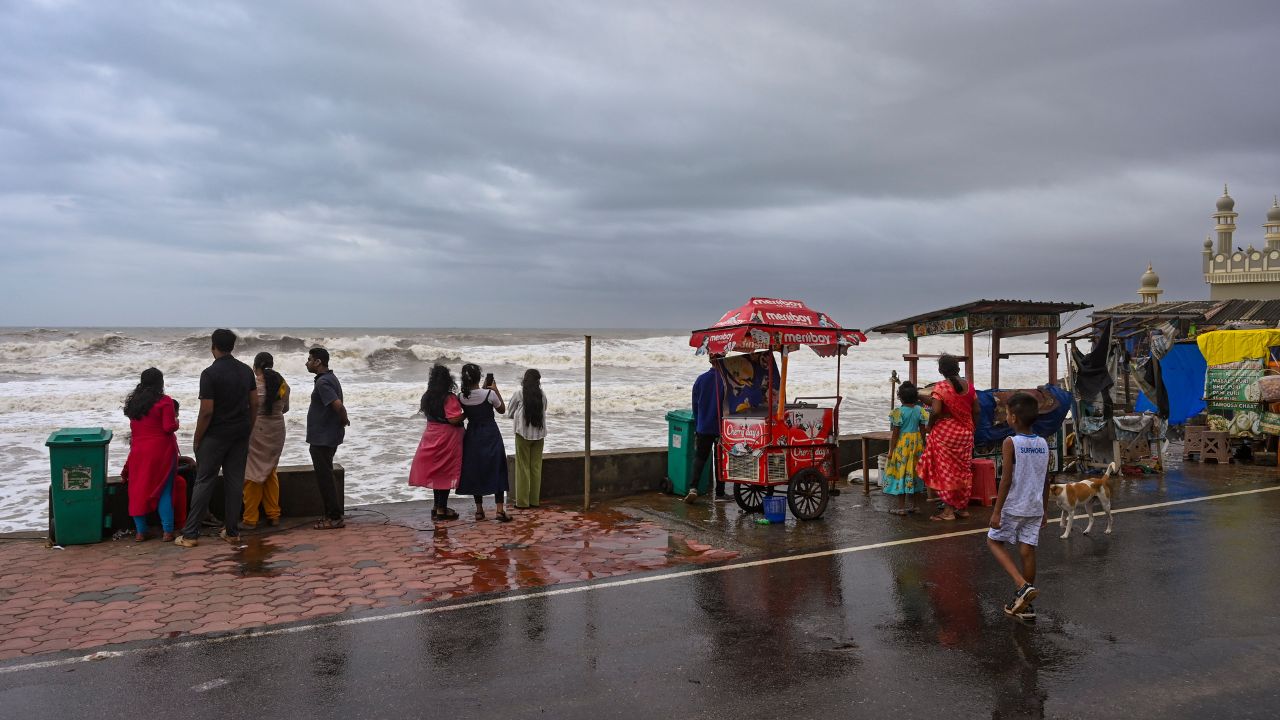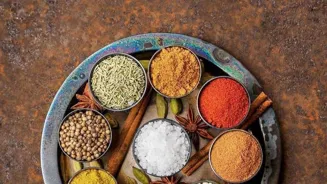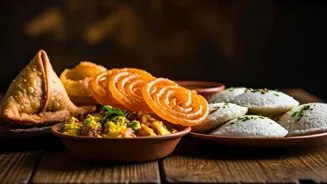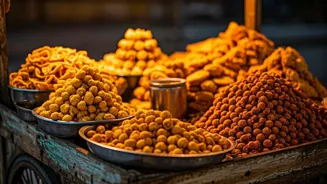Culinary Diversity Unveiled
Maharashtrian cuisine is a beautiful tapestry woven from various threads. The region's diverse geography, including coastal areas, plains, and mountains,
has shaped its culinary landscape. This variety means that different regions specialize in distinct dishes, reflecting the availability of local ingredients and the influence of different communities. Coastal areas emphasize seafood, while the Vidarbha region, known for its spicy cuisine, uses a lot of chili peppers and other spices. The cuisine is also influenced by neighboring states like Goa, Karnataka, and Gujarat, creating a blend of flavors that is uniquely Maharashtrian. From sweet to savory, from simple home-cooked meals to festive delicacies, the food reflects the rich cultural heritage of Maharashtra, making it a true culinary paradise for food lovers. Each bite tells a story of tradition, innovation, and the vibrant spirit of the people.
Street Food Extravaganza
Maharashtra's street food is legendary, offering a delightful array of flavors and aromas. The most famous is *vada pav*, a fluffy potato fritter served inside a bread bun, slathered with chutneys and a dash of spice. Another iconic street food is *pav bhaji*, a flavorful vegetable curry served with buttered bread. *Misal pav* is another spicy dish comprising a mixture of sprouts and lentils, served with a bread bun, chopped onions, and lemon wedges. Then, there is *pani puri*, also known as *gol gappe*, little crispy shells filled with flavored water and tamarind chutney. You will also find *bhel puri*, a mix of puffed rice, vegetables, and chutneys, as well as *sev puri*, topped with various chutneys. The street food scene is not only about taste but also about culture, it brings people together, offering a quick, affordable, and exciting eating experience. It's an integral part of the city's soul, capturing the essence of everyday life.
The Coastal Influence
The coastal region of Maharashtra, which encompasses areas like Mumbai, Thane, and Ratnagiri, is particularly famous for its seafood. The abundance of the Arabian Sea has made fish an integral part of the coastal diet. Dishes like *fish curry*, prepared with a blend of spices and coconut milk, are extremely popular. Various types of fish, prawns, crabs, and other seafood are used in diverse preparations. Another highlight is *bombil fry* (Bombay duck fry), which is a crispy, flavorful snack. The coastal cuisine's flavors reflect the use of ingredients like coconut, tamarind, and various local spices. The food's simplicity and freshness perfectly showcase the flavors of the sea. The food is not just about taste; it also represents the community and lifestyle of the people living near the coast. The flavors of this cuisine can also be tasted in other regions of Maharashtra, offering a glimpse of its coastal heritage.
Beyond Street Food
While street food is a major draw, Maharashtrian cuisine extends far beyond the bustling food stalls. Home-cooked meals are usually quite different, with dishes reflecting the traditions and preferences of the families. *Puran poli*, a sweet flatbread filled with a lentil and jaggery mixture, is a popular festive dish, as is *shrikhand*, a hung yogurt dessert. Another notable dish is *bharli vangi*, which involves eggplants stuffed with a mixture of spices. The use of local spices, like goda masala, gives unique flavors to the food. Lentils, vegetables, and rice play an important role in daily meals. In fact, the home-cooked food shows the depth and the diversity of the Maharashtrian cuisine.
Regional Specialities Explored
Maharashtra's diverse regions provide unique culinary experiences. In the Kolhapur region, food is particularly spicy and flavorful, with dishes like *tambda rassa* (red curry) and *pandhra rassa* (white curry), both of which use distinctive spice blends. The cuisine of the Vidarbha region has a strong influence of the cuisine of the state of Telangana, often featuring *savji mutton*, a dish known for its spice level. In the Khandesh region, food is typically characterized by the use of dry spices, which add to the texture and taste of the dishes. Each region has its cooking style and ingredient choices, showcasing the state's culinary richness. This regional diversity shows the adaptive and vibrant nature of Maharashtrian cuisine, offering a range of flavors and cooking methods for everyone.
The Art of Spices
Spices are the heart and soul of Maharashtrian cooking, adding flavor, aroma, and character to the dishes. The use of goda masala, a specific blend of spices, is common, creating unique flavor profiles. Other spices include turmeric, coriander, cumin, and chili peppers. These spices not only enhance the flavor but also give dishes their distinctive colors. Some spices may also be used for medicinal purposes. The blending of spices has been a tradition passed down through generations. They are usually toasted and ground together to create a unique, complex flavor. The spice blends are a key part of Maharashtrian cuisine, making the food a culinary art form. The flavors vary greatly, from mild to fiery hot, depending on the use of the spices and the region.
Sweet Delights and Desserts
Maharashtra's culinary scene offers a range of desserts that are as delicious as the main courses. *Puran poli*, made during festivals, is a sweet flatbread stuffed with a sweet lentil mixture. *Shrikhand*, made with hung yogurt, sugar, and cardamom, is another favorite dessert. Various other sweets are made during special occasions. The use of milk, jaggery, and ghee are quite common in many desserts. The sweets reflect the culture and the celebrations of Maharashtra. These desserts provide a perfect sweet finish to the meals, and they highlight the variety of Maharashtrian culinary arts. They are cherished, often served during festivals and family gatherings.
Culinary Traditions Preserved
Maharashtrian cuisine shows a strong commitment to preserving its rich food traditions. Recipes and cooking methods have been passed down through generations. Families and communities work hard to protect their culinary heritage. This respect for tradition ensures that the authentic flavors of Maharashtra stay alive. Modern cooks, chefs, and home cooks contribute to the preservation of traditional dishes while also adapting to new culinary trends. There is a growing awareness of the value of traditional recipes and the need to protect them. This focus ensures that future generations will continue to experience the delicious food of Maharashtra.







